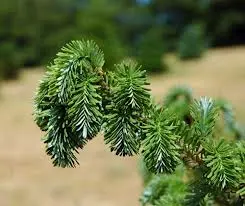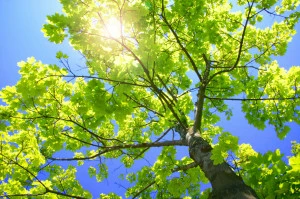 Remember the summer of 2012? Wisconsin along with much of the nation experienced a severe drought. If you were a client of Beautiful Blooms, then you may recall an E-Mail we sent out, suggesting that you forgo setting up the sprinkler to water your lawn and focus on saving your trees and shrubs instead. The reasoning behind this was that you have invested a large amount of time (as in, years!) and money (possibly hundreds or even thousands of dollars) in your mature trees and shrubs and they are not easily replaceable, unlike turf, annuals and perennials. Your loss would be greater if a 35 ft Autumn Blaze Maple were to die than if your Picasso Geraniums died. I’m sure many of you followed her advice, but I’m also guessing some of you did not. And it may be because you simply did not know how to go about it, so let’s address that so the next time we face a drought of that magnitude- and we will- you are prepared to save those trees and larger shrubs!
Remember the summer of 2012? Wisconsin along with much of the nation experienced a severe drought. If you were a client of Beautiful Blooms, then you may recall an E-Mail we sent out, suggesting that you forgo setting up the sprinkler to water your lawn and focus on saving your trees and shrubs instead. The reasoning behind this was that you have invested a large amount of time (as in, years!) and money (possibly hundreds or even thousands of dollars) in your mature trees and shrubs and they are not easily replaceable, unlike turf, annuals and perennials. Your loss would be greater if a 35 ft Autumn Blaze Maple were to die than if your Picasso Geraniums died. I’m sure many of you followed her advice, but I’m also guessing some of you did not. And it may be because you simply did not know how to go about it, so let’s address that so the next time we face a drought of that magnitude- and we will- you are prepared to save those trees and larger shrubs!
Irrigation can account for up to 75% of annual municipal water use (according to a study by the University of Utah) and much of it is applied in excess of a plants needs due to over-spray and improper watering techniques. Proper irrigation encourages deeper root growth which leads to healthier more drought tolerant plants. Trees take up and use a lot of water when the temperature climbs, the problem is that, they do not show wilt as easily as other plants. Sometimes this makes it difficult for the homeowner to detect their need for water. On the bright side, trees and shrubs do not need to be watered every single day- not even every week! A bi-weekly watering should be sufficient as long as it is being done properly.
 So, how do you know when it’s time to get out the hose? The easiest method is the “feel method” feel or squeeze a handful of soil to get a good idea of moisture level. Make sure you get a sample from a depth of 4-8 inches, since the soil on the surface will always dry out faster than the rest. When moisture levels are ideal for the plant- the soil will form a ball when you squeeze it, and a thin layer of moisture will be on your hand. However, no water should run out of the ball, nor should the ball crumble apart.
So, how do you know when it’s time to get out the hose? The easiest method is the “feel method” feel or squeeze a handful of soil to get a good idea of moisture level. Make sure you get a sample from a depth of 4-8 inches, since the soil on the surface will always dry out faster than the rest. When moisture levels are ideal for the plant- the soil will form a ball when you squeeze it, and a thin layer of moisture will be on your hand. However, no water should run out of the ball, nor should the ball crumble apart.
 Once you have determined whether or not your woody plant needs watering, you need to make sure the water is, indeed, getting to where it needs to be. The biggest mistake I see homeowners make again and again, is setting up the lawn sprinkler, letting it run for an hour in the afternoon, and assuming that all is well. Nothing could be farther than the truth! While it’s true that trees and shrubs located in turf areas, can benefit from typical lawn irrigation, it’s simply not enough. Trees and shrubs should be watered to a depth of 18-20 in. Yes, you read that right- over a foot down in the root zone. By allowing water to penetrate that far down, you are encouraging deeper rooting and a more drought tolerant plant. The best way to do that is to use a soaker hose of some type. In drip irrigation, water flows through flexible hoses and is applied directly to the root zone of the plants. In this way, little water is lost due to evaporation to the air, or run-off from the soil and the system actually uses less water than traditional landscape sprinklers.
Once you have determined whether or not your woody plant needs watering, you need to make sure the water is, indeed, getting to where it needs to be. The biggest mistake I see homeowners make again and again, is setting up the lawn sprinkler, letting it run for an hour in the afternoon, and assuming that all is well. Nothing could be farther than the truth! While it’s true that trees and shrubs located in turf areas, can benefit from typical lawn irrigation, it’s simply not enough. Trees and shrubs should be watered to a depth of 18-20 in. Yes, you read that right- over a foot down in the root zone. By allowing water to penetrate that far down, you are encouraging deeper rooting and a more drought tolerant plant. The best way to do that is to use a soaker hose of some type. In drip irrigation, water flows through flexible hoses and is applied directly to the root zone of the plants. In this way, little water is lost due to evaporation to the air, or run-off from the soil and the system actually uses less water than traditional landscape sprinklers.
If you do not want to spend the money on buying soaker hoses, you can use the regular garden hose you already have. In this case, you remove the nozzle from your hose and place the hose opening approximately 6 inches from the trunk. Apply a small stream of water to soak the ground/root zone for 3-15 minutes, depending on the size of your tree or shrub. Walk away and go do something else, pull weeds, refill the bird feeder, whatever- It’s boring just standing there watching a tree get watered, right? Just remember to come back when time is up. Over watering a tree or shrub is just as bad- but that’s a topic for another blog. J
Here is a general table to estimate watering time.
-Shrubs: 3 minutes
-Ornamental (flowering crabs, cherry, etc…) 10 minutes
-Evergreens (up to 6 feet) 15 min
-Deciduous trees (2-3 inch caliper) 15 minutes
-Add 15 minutes watering time for every caliper inch over the 2-3 inches
Horticulturists all agree that we will be seeing effects of the 2012 drought for the next 3-4 years. Proper watering of the woody plants in your landscape can increase the beauty of your yard, and the value of your property, preserving your investments for perhaps, generations!


Comments (0)
Sorry! The comments have been closed.